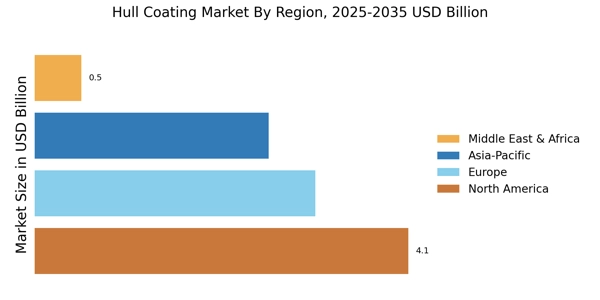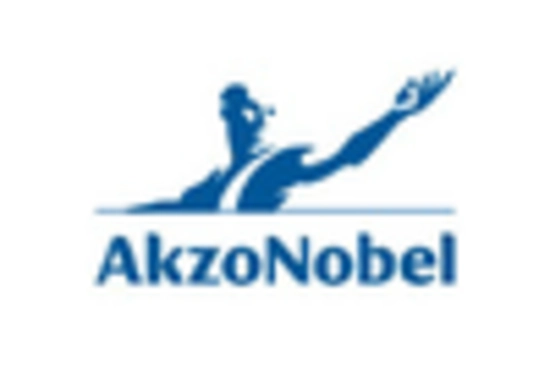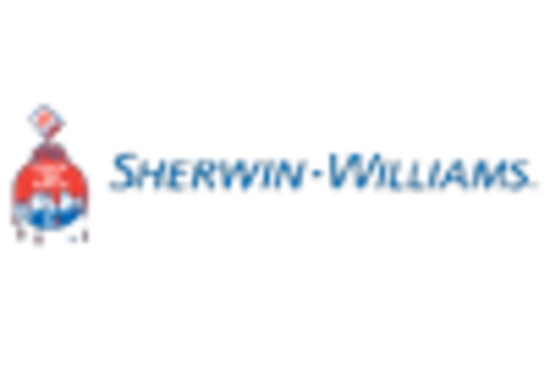Environmental Regulations
The Hull Coating Market is increasingly influenced by stringent environmental regulations aimed at reducing pollution and protecting marine ecosystems. Governments worldwide are implementing laws that restrict the use of harmful substances in marine coatings, such as biocides and heavy metals. This regulatory landscape compels manufacturers to innovate and develop eco-friendly alternatives, thereby driving growth in the Hull Coating Market. The demand for low-VOC and non-toxic coatings is on the rise, as shipbuilders and operators seek compliance with these regulations. As a result, the market is witnessing a shift towards sustainable products, which not only meet regulatory standards but also appeal to environmentally conscious consumers. This trend is expected to continue, potentially reshaping the competitive dynamics within the Hull Coating Market.
Technological Innovations
Technological innovations play a pivotal role in shaping the Hull Coating Market. The advent of advanced coating technologies, such as nanotechnology and smart coatings, is revolutionizing the way hulls are protected and maintained. These innovations not only enhance the durability and performance of coatings but also reduce maintenance costs for vessel operators. For instance, self-cleaning coatings that utilize hydrophobic properties are gaining traction, as they minimize biofouling and improve fuel efficiency. The Hull Coating Market is witnessing increased investment in research and development to create coatings that can withstand harsh marine environments while providing long-lasting protection. As these technologies continue to evolve, they are expected to drive market growth and offer competitive advantages to manufacturers who can deliver cutting-edge solutions.
Expansion of Marine Tourism
The Hull Coating Market is benefiting from the expansion of marine tourism, which has seen a notable increase in leisure vessels and cruise ships. As more individuals seek unique travel experiences on the water, the demand for yachts and cruise liners is rising. This trend necessitates the use of high-quality hull coatings that provide aesthetic appeal and protection against the harsh marine environment. The marine tourism sector is projected to grow at a robust rate, further fueling the Hull Coating Market. Shipowners are increasingly prioritizing coatings that enhance the visual appeal of their vessels while ensuring durability and performance. This intersection of tourism and coating technology is likely to create new avenues for growth and innovation within the Hull Coating Market.
Rising Shipbuilding Activities
The Hull Coating Market is experiencing a surge in demand due to rising shipbuilding activities across various regions. As economies recover and trade activities expand, shipyards are ramping up production to meet the increasing need for cargo and passenger vessels. According to recent data, the shipbuilding sector is projected to grow at a compound annual growth rate of approximately 3.5% over the next few years. This growth directly correlates with the demand for advanced hull coatings that enhance vessel performance and longevity. Shipbuilders are increasingly investing in high-performance coatings that offer superior protection against corrosion and fouling, thereby driving the Hull Coating Market forward. The interplay between shipbuilding growth and coating innovations is likely to create new opportunities for manufacturers and suppliers in this sector.
Growing Demand for Maintenance and Repair
The Hull Coating Market is significantly influenced by the growing demand for maintenance and repair services in the maritime sector. As vessels age, the need for regular maintenance becomes critical to ensure operational efficiency and safety. This trend is particularly evident in the commercial shipping and fishing industries, where downtime can lead to substantial financial losses. Consequently, ship operators are increasingly investing in high-quality hull coatings that not only protect against corrosion but also extend the lifespan of their vessels. The maintenance and repair segment is projected to account for a considerable share of the Hull Coating Market, as operators seek to enhance the performance and aesthetics of their fleets. This growing focus on maintenance is likely to drive demand for innovative coating solutions that offer long-term benefits.


















Leave a Comment